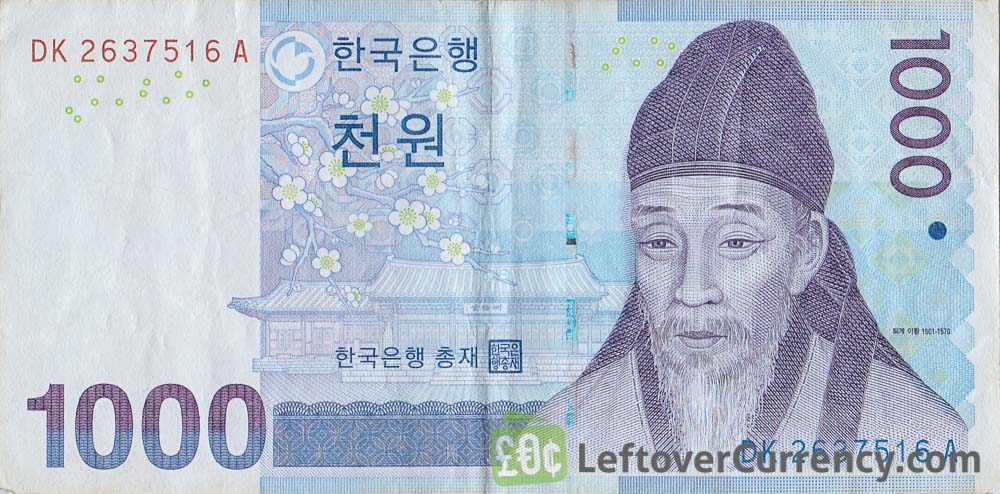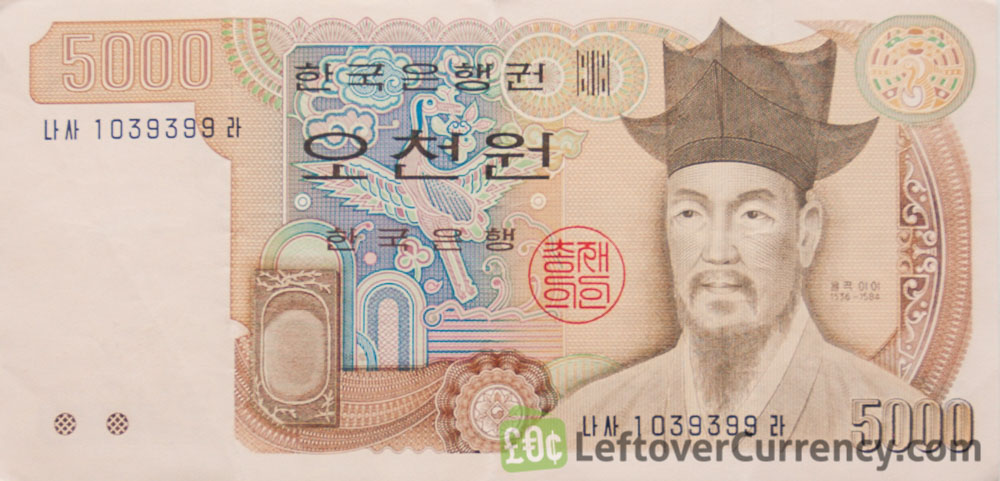South Korea
Showing 1–16 of 37 results
-
1000 South Korean won banknote (2007 issue)
The portrait on this 1,000 won banknote from South Korea is of Yi Hwang, a Confucian scholar and contemporary of Yi l (who features on the 5,000 won note). Yi Hwang wrote under the nom de plume Toegye, and was also known as Gyeongho. He established the Dosan Seowan, a private academy for practice and … ContinuedYou get: £0.470001 KRW = £0.0004700000 -
10000 South Korean won banknote (Gyeonghoeru Pavilion)
These older 10,000 won banknotes from the Republic of Korea (South Korea) feature a portrait of Sejong the Great. They also show Korea’s National Treasure ‘Borugak Jagyeongnu’, the water clock of Borugak Pavilion, on the obverse side. The reverse side of the old 5000 won note shows the beautiful Khonghoeru Pavilion, part of the Gyeongbokgung … ContinuedYou get: £3.800001 KRW = £0.0003800000 -
2000 South Korean Won banknote (2018 Winter Olympics)
This commemorative banknote of 2000 wons was issued in honour of the PyeongChang 2018 Olympic Winter Games in South Korea. The grey-white and blue coloured 2000 KRW banknote features the seven official sports from the PyeongChang 2018 Winter Games: biathlon, bobsleigh, curling, ice hockey, luge, ski jumping and speed skating. The front of the banknote … ContinuedYou get: £0.940001 KRW = £0.0004700000 -
500 South Korean won coin
The silver coloured 500 won coin from South Korea is made from copper-nickel. The bird on the reverse side of the 500 KRW coin is a flying red-crowned crane, also known as Manchurian crane. The coin’s value is written out in Hangul, the alphabet used for the Korean language. The reverse side of the 500 … ContinuedYou get: £0.140001 KRW = £0.0002800000 -
100 South Korean won coin
Admiral Yi Sun-sin is depicted on this 100 won coin from South Korea. Admiral Yi Sun-sin was one of the most successful naval commanders of all time, with at least 23 successes and no defeats in battles at sea. His most famous victory was at the Battle of Myeongnyang in 1597, where he defeated a … ContinuedYou get: £0.028001 KRW = £0.0002800000 -
10000 South Korean won banknote (1979 issue)
The undated 1979 issue of the 10,000 South Korean won banknote features a portrait of the fourth King of the Joseon dynastie, Sejong the Great. On the back of the old 10,000 KRW note is a pagode from the largest of the Five Grand Palaces built by the Joseon dynasty: Gyeongbokgung.You get: £3.800001 KRW = £0.0003800000 -
5000 South Korean won banknote (2006 issue)
The 5,000 won banknote from the Republic of Korea features Yi l, who wrote under the name Yulgok. He is the son of Shin Saimdang, the woman portrayed on the 50,000 won banknote. In addition to being an acclaimed Confuscian scholar like his mother, he was also actively involved in politics and helped to bring … ContinuedYou get: £2.350001 KRW = £0.0004700000 -
100 South Korean won coin (old type)
The old style 100 South Korean won coin features national hero Admiral Yi Sun-sin. The 100 won piece from the old type does not feature text in Hangul on both sides, unlike many other South Korean coins. The old 100 won coin is made of cupronickel and weighs 5.42 grams, with a diameter of 24mm.You get: £0.028001 KRW = £0.0002800000 -
10000 South Korean won banknote (1973 issue)
The brown coloured 10,000 won banknote from The Bank of Korea’s undated 1973 issue features the portrait of King Sejong The Great, fourth ruler of Korea’s Sejong dynasty. On the back side is an image of Gyeongbok Palace, part of the Gyeongbokgung complex in Seoul.You get: £3.800001 KRW = £0.0003800000 -
10000 South Korean won banknote (2007 issue)
The 10,000 won banknote has the portrait of Sejong the Great, the 15th Century ruler of the Josean Korean kingdom. He is credited with making Confucianism the norm in Korean society, and was the first to appoint people from across the social spectrum to government roles. The reverse of the 10,000 KRW bill shows the … ContinuedYou get: £4.700001 KRW = £0.0004700000 -
50 South Korean won coin
This 50 won coin from the Republic of Korea (South Korea) is made from copper, nickel and zinc. The stalks of the rice plant are shown on the reverse side of the coin. The Hangul (Korean) text on the 50 South Korean won piece reads ‘Bank of Korea’, Korea’s central bank.You get: £0.014001 KRW = £0.0002800000 -
5000 South Korean won banknote (Ojukheon House)
This old type 5,000 won South Korean banknote depicts Yi l,one of the most prominent Confucian scholars from the Joseon Dynasty, who is also known by his pen name ‘Yulgok’. The reverse of the 5000 Korean Won note shows Ojukheon, the house where Yi l was born, and home to his mother Shin Saimdang, also … ContinuedYou get: £1.900001 KRW = £0.0003800000 -
50000 South Korean won banknote (2009 issue)
This brown and yellow 50,000 won banknote is the first Korean banknote to feature a woman’s portrait. It depicts Shin Saimdang, a 16th Century Korean artist and writer, and mother of Yulgok, the scholar featured on the 5,000 won note. Shin (or Sin) Saimdang also used the noms de plume Imsajae and Inimdang. She is … ContinuedYou get: £23.500001 KRW = £0.0004700000 -
50 South Korean won coin (old type)
This old type 50 won coin from the Republic of Korea (South Korea) is made from copper-nickel. It depicts an ear of rice on one side, and the denomination and date of issue on the reverse side. The old 50 KRW coin weighs 4.16 grams and measures 21.6mm across.You get: £0.014001 KRW = £0.0002800000 -
10 South Korean won coin
This is the 10 South Korean won coin from the 4th Series. Previous versions of the 10 won coin were struck in brass or bronze. Because the metal value of brass and bronze 10 won coins now exceeds their face value, the 4th issue was cast in less valuable copper-plated aluminium instead. The building on … ContinuedYou get: £0.002801 KRW = £0.0002800000

 Loading
Loading
 Filter
Filter


















